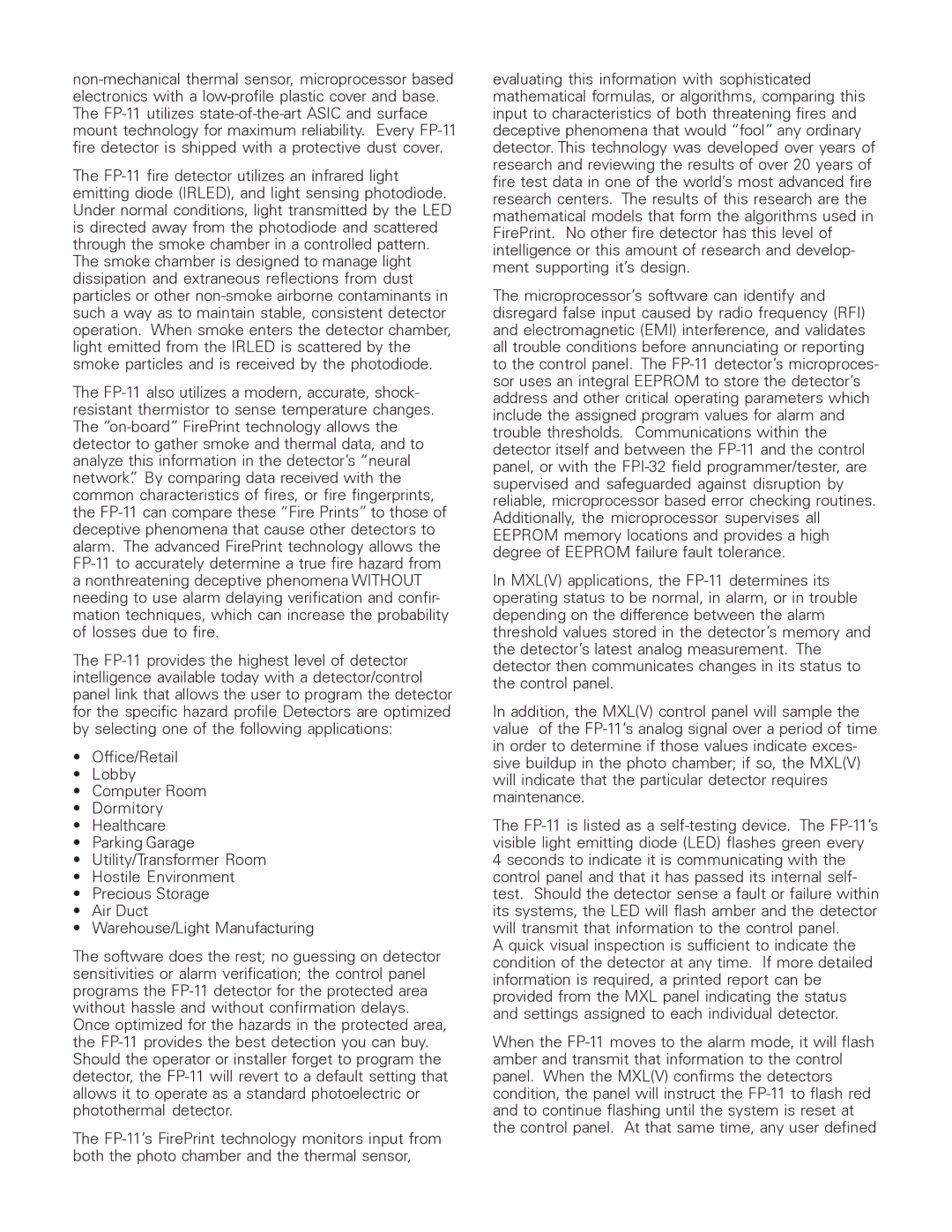non-mechanical thermal sensor, microprocessor based electronics with a low-profile plastic cover and base. The FP-11 utilizes state-of-the-art ASIC and surface mount technology for maximum reliability. Every FP-11 fire detector is shipped with a protective dust cover.
The FP-11 fire detector utilizes an infrared light emitting diode (IRLED), and light sensing photodiode. Under normal conditions, light transmitted by the LED is directed away from the photodiode and scattered through the smoke chamber in a controlled pattern. The smoke chamber is designed to manage light dissipation and extraneous reflections from dust particles or other non-smoke airborne contaminants in such a way as to maintain stable, consistent detector operation. When smoke enters the detector chamber, light emitted from the IRLED is scattered by the smoke particles and is received by the photodiode.
The FP-11 also utilizes a modern, accurate, shock- resistant thermistor to sense temperature changes. The “on-board” FirePrint technology allows the detector to gather smoke and thermal data, and to analyze this information in the detector’s “neural network”. By comparing data received with the common characteristics of fires, or fire fingerprints, the FP-11 can compare these “Fire Prints” to those of deceptive phenomena that cause other detectors to alarm. The advanced FirePrint technology allows the FP-11 to accurately determine a true fire hazard from a nonthreatening deceptive phenomena WITHOUT needing to use alarm delaying verification and confir- mation techniques, which can increase the probability of losses due to fire.
The FP-11 provides the highest level of detector intelligence available today with a detector/control panel link that allows the user to program the detector for the specific hazard profile Detectors are optimized by selecting one of the following applications:
•Office/Retail
•Lobby
•Computer Room
•Dormitory
•Healthcare
•Parking Garage
•Utility/Transformer Room
•Hostile Environment
•Precious Storage
•Air Duct
•Warehouse/Light Manufacturing
The software does the rest; no guessing on detector sensitivities or alarm verification; the control panel programs the FP-11 detector for the protected area without hassle and without confirmation delays. Once optimized for the hazards in the protected area, the FP-11 provides the best detection you can buy. Should the operator or installer forget to program the detector, the FP-11 will revert to a default setting that allows it to operate as a standard photoelectric or photothermal detector.
The FP-11’s FirePrint technology monitors input from both the photo chamber and the thermal sensor,
evaluating this information with sophisticated mathematical formulas, or algorithms, comparing this input to characteristics of both threatening fires and deceptive phenomena that would “fool” any ordinary detector. This technology was developed over years of research and reviewing the results of over 20 years of fire test data in one of the world’s most advanced fire research centers. The results of this research are the mathematical models that form the algorithms used in FirePrint. No other fire detector has this level of intelligence or this amount of research and develop- ment supporting it’s design.
The microprocessor’s software can identify and disregard false input caused by radio frequency (RFI) and electromagnetic (EMI) interference, and validates all trouble conditions before annunciating or reporting to the control panel. The FP-11 detector’s microproces- sor uses an integral EEPROM to store the detector’s address and other critical operating parameters which include the assigned program values for alarm and trouble thresholds. Communications within the detector itself and between the FP-11 and the control panel, or with the FPI-32 field programmer/tester, are supervised and safeguarded against disruption by reliable, microprocessor based error checking routines. Additionally, the microprocessor supervises all EEPROM memory locations and provides a high degree of EEPROM failure fault tolerance.
In MXL(V) applications, the FP-11 determines its operating status to be normal, in alarm, or in trouble depending on the difference between the alarm threshold values stored in the detector’s memory and the detector’s latest analog measurement. The detector then communicates changes in its status to the control panel.
In addition, the MXL(V) control panel will sample the value of the FP-11’s analog signal over a period of time in order to determine if those values indicate exces- sive buildup in the photo chamber; if so, the MXL(V) will indicate that the particular detector requires maintenance.
The FP-11 is listed as a self-testing device. The FP-11’s visible light emitting diode (LED) flashes green every 4 seconds to indicate it is communicating with the control panel and that it has passed its internal self- test. Should the detector sense a fault or failure within its systems, the LED will flash amber and the detector will transmit that information to the control panel.
A quick visual inspection is sufficient to indicate the condition of the detector at any time. If more detailed information is required, a printed report can be provided from the MXL panel indicating the status and settings assigned to each individual detector.
When the FP-11 moves to the alarm mode, it will flash amber and transmit that information to the control panel. When the MXL(V) confirms the detectors condition, the panel will instruct the FP-11 to flash red and to continue flashing until the system is reset at the control panel. At that same time, any user defined
